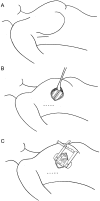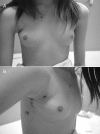Small right vertical infra-axillary incision for minimally invasive port-access cardiac surgery: a moving window method
- PMID: 23293265
- PMCID: PMC3598043
- DOI: 10.1093/icvts/ivs544
Small right vertical infra-axillary incision for minimally invasive port-access cardiac surgery: a moving window method
Abstract
Port-access cardiac surgery has been developed to minimize skin incision and improve cosmetic outcomes. Using this method, a skin incision is generally made just above where the thoracotomy will be placed, horizontally along the intercostal space at the anterolateral submammary position. However, this type of incision can affect the frontal view and shape of the breast. Here, we report our experience with minimally invasive cardiac surgery using a port-access approach via a small vertical right infra-axillary incision and a moving window method. Twenty patients underwent surgical procedures with this approach from December 2010 to January 2012. Thirteen patients underwent mitral valvuloplasty, four mitral valve replacement, one mitral and tricuspid valve replacement and atrial septal defect closure and two atrial septal defect closure. All surgical procedures were completed using this minimally invasive method. All patients had an uneventful recovery and indicated that they were satisfied with the cosmetic results during the follow-up. Our experience suggests that this technique can effectively minimize skin incision and improve cosmetic outcomes.
Figures


Similar articles
-
[Experiments on minimally invasive open heart surgery using right anterolateral minithoracotomy].Anadolu Kardiyol Derg. 2002 Dec;2(4):309-12. Anadolu Kardiyol Derg. 2002. PMID: 12460828 Turkish.
-
Facile minimally invasive cardiac surgery via ministernotomy.Ann Thorac Surg. 1998 Apr;65(4):1100-4. doi: 10.1016/s0003-4975(98)00064-2. Ann Thorac Surg. 1998. PMID: 9564935
-
Port-access approach for cardiac surgical procedures: our experience in 776 patients.Indian Heart J. 2005 Nov-Dec;57(6):688-93. Indian Heart J. 2005. PMID: 16521639
-
[Minimally Invasive Cardiac Surgery( MICS) through a Mini-right Thoracotomy].Kyobu Geka. 2015 Jan;68(1):11-5. Kyobu Geka. 2015. PMID: 25595155 Review. Japanese.
-
[Right thoracotomy approach for minimally invasive mitral valve surgery].Khirurgiia (Mosk). 2019;(12):121-125. doi: 10.17116/hirurgia2019121121. Khirurgiia (Mosk). 2019. PMID: 31825352 Review. Russian.
Cited by
-
Rightvertical axillary incision for atrial septal defect: a propensity score matched study.J Cardiothorac Surg. 2022 Oct 5;17(1):256. doi: 10.1186/s13019-022-01999-0. J Cardiothorac Surg. 2022. PMID: 36199116 Free PMC article.
-
Quadricuspid Aortic Valve with Ruptured Sinus of Valsalva Aneurysm: a Case Report.Braz J Cardiovasc Surg. 2023 Feb 10;38(1):170-4. doi: 10.21470/1678-9741-2020-0735. Braz J Cardiovasc Surg. 2023. PMID: 35072405 Free PMC article.
-
Right infra-axillary mini-thoracotomy for aortic valve replacement.Ann Cardiothorac Surg. 2015 Jan;4(1):57-8. doi: 10.3978/j.issn.2225-319X.2014.11.11. Ann Cardiothorac Surg. 2015. PMID: 25694977 Free PMC article. No abstract available.
-
Comparative Study between Surgical Repair of Atrial Septal Defect via Median Sternotomy, Right Submammary Thoracotomy, and Right Vertical Infra-Axillary Thoracotomy.Braz J Cardiovasc Surg. 2020 Jun 1;35(3):285-290. doi: 10.21470/1678-9741-2019-0096. Braz J Cardiovasc Surg. 2020. PMID: 32549099 Free PMC article.
References
-
- Grossi EA, Galloway AC, LaPietra A, Ribakove GH, Ursomanno P, Delianides J, et al. Minimally invasive mitral valve surgery: a 6-year experience with 714 patients. Ann Thorac Surg. 2002;74:660–3. - PubMed
-
- Vistarini N, Aiello M, Mattiucci G, Alloni A, Cattadori B, Tinelli C, et al. Port-access minimally invasive surgery for atrial septal defects: a 10-year single-center experience in 166 patients. J Thorac Cardiovasc Surg. 2010;139:139–45. - PubMed
-
- Wang D, Wang Q, Yang X, Wu Q, Li Q. Mitral valve replacement through a minimal right vertical infra-axillary thoracotomy versus standard median sternotomy. Ann Thorac Surg. 2009;87:704–8. - PubMed
-
- Van Raemdonck D, Coosemans W, Lerut T. Vertical axillary thoracotomy; a muscle-sparing approach for routine thoracic operations. Acta Chir Belg. 1993;93:207–11. - PubMed
-
- Yamashita K, Shimizu K. Transaxillary retromammary route approach of video-assisted breast surgery enables the inner-side breast cancer to be resected for breast conserving surgery. Am J Surg. 2008;196:578–81. - PubMed
MeSH terms
LinkOut - more resources
Full Text Sources
Other Literature Sources

